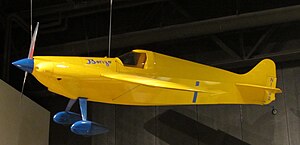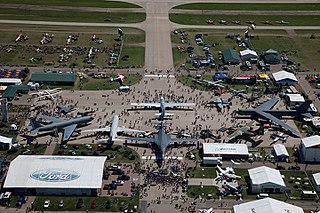
EAA AirVenture Oshkosh, or just Oshkosh, is an annual air show and gathering of aviation enthusiasts held each summer at Wittman Regional Airport and adjacent Pioneer Airport in Oshkosh, Wisconsin, United States. The southern part of the show grounds, as well as Camp Scholler, are located in the town of Nekimi and a base for seaplanes on Lake Winnebago is in Black Wolf.

Oshkosh is a city in and the county seat of Winnebago County, Wisconsin, United States. The city had a population of 66,816 in 2020, making it the ninth-largest city in Wisconsin. It is also adjacent to the Town of Oshkosh.

The Laird LC-DW300 and LC-DW500 Super Solution aka "Sky Buzzard" was a racing biplane built in the early 1930s by Matty Laird for the Cleveland Speed Foundation, Laird was already famous in the air racing circuit. It had a large radial engine and an extremely faired windshield. Other than being a biplane, it was similar in appearance to the Gee Bee, a more famous racer from the period. It was an advanced design for the time because of the relatively clean aerodynamic construction and tight engine cowling.

The Gee Bee Model R Super Sportster was a special-purpose racing aircraft made by Granville Brothers Aircraft of Springfield, Massachusetts at the now-abandoned Springfield Airport. Gee Bee stands for Granville Brothers.
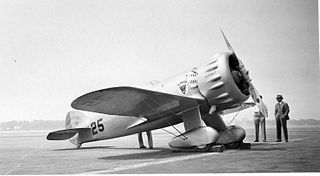
The Wedell-Williams Model 44 is a racing aircraft, four examples of which were built in the United States in the early 1930s by the Wedell-Williams Air Service Corporation. It began as a rebuilding of the partnership's successful We-Will 1929 racer, but soon turned into a completely new racing monoplane aircraft, powered by a large radial engine. Model 44s became the dominant racers of the 1930s, setting innumerable records including setting a new world speed record in 1933.
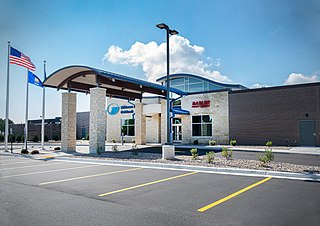
Wittman Regional Airport is a county-owned public-use airport located two nautical miles (4 km) south of the central business district of Oshkosh, a city in Winnebago County, Wisconsin, United States. A large portion at the south end of the airport is located in the town of Nekimi. It is located adjacent to Pioneer Airport, part of the EAA Aviation Museum.

The Cirrus VK-30 is a single-engine pusher-propeller homebuilt aircraft originally sold as a kit by Cirrus Design, and was the company's first model, introduced in 1987.

The EAA Aviation Museum, formerly the EAA AirVenture Museum, is a museum dedicated to the preservation and display of historic and experimental aircraft as well as antiques, classics, and warbirds. The museum is located in Oshkosh, Wisconsin, United States, adjacent to Wittman Regional Airport, home of the museum's sponsoring organization, the Experimental Aircraft Association (EAA), and the organization's EAA AirVenture Oshkosh event that takes place in late July/early August.

Sylvester Joseph "Steve" Wittman was an American air-racer and aircraft engineer.

The Wittman V-Witt also called Witts V and Witt's Vee is single-engine tube-and-fabric construction aircraft specifically made for Formula V Air Racing.

The H-10 Pheasant was a tandem-seat conventional landing gear-equipped biplane with fabric covering, built in 1928 by the Pheasant Aircraft Company to compete in the crowded market of barnstorming biplanes. The company dissolved shortly after, during the Great Depression of the early 1930s.
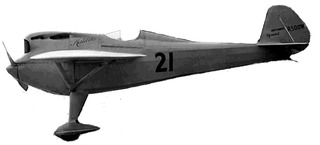
The Folkerts SK-1,Speed King One, Mono Special, Matilda, Fordon-Neumann Special, Hardwick-Whittenbeck Special was a racer built for the 1930 American Cirrus Aircraft Engine Company sponsored American Cirrus Derby.

The Folkerts SK-2, also known as Speed King Two, "Toots" and "Miss Detroit" was a racer built for the 1936 National Air Races

Chief Oshkosha.k.a.Buster is a homebuilt racing plane designed to compete in the 1931 American Cirrus Races.

The Wittman D-12 "Bonzo" was an air racer designed by Steve Wittman for the Thompson Trophy races. The aircraft's top speed of 325 mph (523 km/h) made it faster than any United States military aircraft of the era.
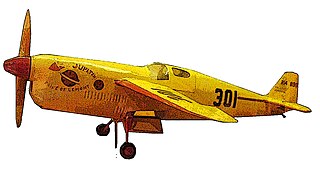
The Folkerts SK-3 a.k.a. "Jupiter, Pride of Lemont" was the third in a series of air racers developed by Clayton Folkerts.

The Howard DGA-3 "Pete", a.k.a. "Damned Good Airplane – 3", "Baker Special", and "Little Audrey" was the third aircraft built by Ben Howard, and the first in a series of racing aircraft. Howard claimed that the aircraft was so fast from his use of "Go Grease".

The Nicholas-Beazley Pobjoy Special aka the Nicholas-Beazley Phantom I, aka the Wittman Phantom, aka the Flagg Phantom, aka the Reaver Special was a world record holding air racer of the 1930s

The Rider R-6 was the last of the Keith Rider designed racing aircraft of the 1930s.
The Christensen Zipper is an air racer that was built to compete in the Goodyear midget air races.
